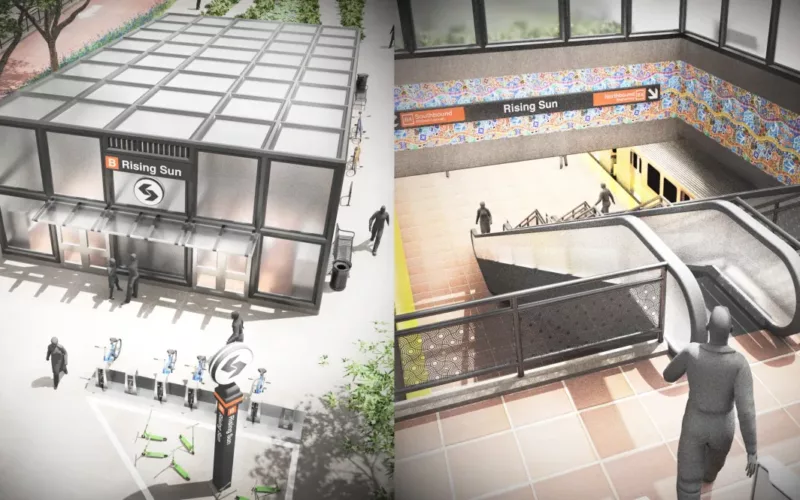

A public plaza spotted on the way to visit LA DOT. Photo by Shin-pei Tsay
Though Los Angeles is the land of big industry, splashy projects, and outsized personalities, the images that lingered the most from a visit last month are the smaller details, more easily overlooked. The city of LA would rank 18th in the world compared against national GDPs (nominal 2013), and to see it from the air from the window of an approaching jetliner is to grasp its scale. But now when you look up close, small-scale mechanisms are becoming more apparent. They help punctuate the city’s disparate parts, suggesting that change will be ushered in through more nuanced and complementary ways.
Reclaimed pedestrian spaces attached to the redesign of major corridors, complete with dedicated bus lanes, make transit choices more legible. LA’s fabled car-oriented arterials are now also the domain of the frequent LA Rapid bus lines, and the increasingly bustling downtown is the province of LA DOT’s DASH service, with a bus rarely more than a few minutes away. And beyond the city limits, operators like the Big Blue Bus in Santa Monica and Long Beach Transit and Foothills Transit are expansionary operators. (TransitCenter staff partook in all of these options during a recent visit, of course.)

TransitCenter staff catching the Big Blue Bus with MoveLA and former Santa Monica mayor Denny Zane and NRDC’s Amanda Eaken. Photo by David Bragdon
In downtown LA, new street design distinguished Broadway Boulevard from Spring Street, its paralleling neighbor. Walking down one street is now indisputably different from walking on the other, erasing memories of blurry expeditions on look-alike streets. Other neighborhoods will also experience this game-changer since Mayor Eric Garcetti will be continuing this work through the Great Streets program.

Photo by Shin-pei Tsay
Parklets have sprouted, offering additional seating and exercycles, planting a sense of place and will contribute to the creation of a formal public space program. But here’s no surprise: these street redesigns and safety improvements have lured people back to a once-desolate downtown, and the sidewalks of one of LA’s core districts are now abundant with pedestrians.

Photo by Shin-pei Tsay
The fact that these small-scale changes have popped up in the public realm and are being woven into the practices of the city indicates a new direction for the region after Measure R, the county-wide ballot measure that raised funding dedicated to transit investments. (The LA region then accelerated that investment so that 30 years worth of transit would be implemented within 10.) That new direction will provide and strengthen connections to transit, known as the first and last mile challenge.
First and last mile issues in a transit trip may be literally and figuratively on the margins of big infrastructure projects. But if the stations on LA’s rapidly expanding transit network are difficult to find and reach, LA’s huge transit investments won’t fulfill their potential. Resolutions to those challenges will augur success or failure.
LA’s transit planning leadership already recognizes this challenge. A good first sign is that LA Metro complemented the forthcoming transit investments with its recently published First and Last Mile Strategic Plan. California is also leading the United States with its climate change-motivated integrated land use and transportation policies. With the passage of AB32, California’s climate change act, and SB375, California’s regional land use and transportation planning mandate, the state has enacted policies that give regional authorities the instruments and muscle to compel a change in development and planning practices and advance the shift to more sustainable urbanism.
The smaller public space projects and the statewide policy frameworks speak to the region’s potential. By addressing the gap, the region would demonstrate that the City of the Automobile can be re-invented as the City of All Mobility. Member organizations in the Measure R coalition have newfound energy to make good on these leading-edge policies. As they noted themselves, policies are only as good as implementation. That’s why the smaller threads that weave these big projects into a coherent whole will become ever more critical. This is an exciting new phase for LA’s evolution and we’re thrilled to be a part of it, working with a coalition that will make LA’s transit more accessible to more people throughout the city and region.
 On the Brink: Will WMATA’s Progress Be Erased by 2024?
On the Brink: Will WMATA’s Progress Be Erased by 2024?
The experience of being a WMATA rider has substantially improved over the last 18 months, thanks to changes the agency has made like adding off-peak service and simplifying fares. Things are about to get even better with the launch of all-door boarding later this fall, overnight bus service on some lines starting in December, and an ambitious plan to redesign the Metrobus network. But all of this could go away by July 1, 2024.
Read More To Achieve Justice and Climate Outcomes, Fund These Transit Capital Projects
To Achieve Justice and Climate Outcomes, Fund These Transit Capital Projects
Transit advocates, organizers, and riders are calling on local and state agencies along with the USDOT to advance projects designed to improve the mobility of Black and Brown individuals at a time when there is unprecedented funding and an equitable framework to transform transportation infrastructure, support the climate, and right historic injustices.
Read More